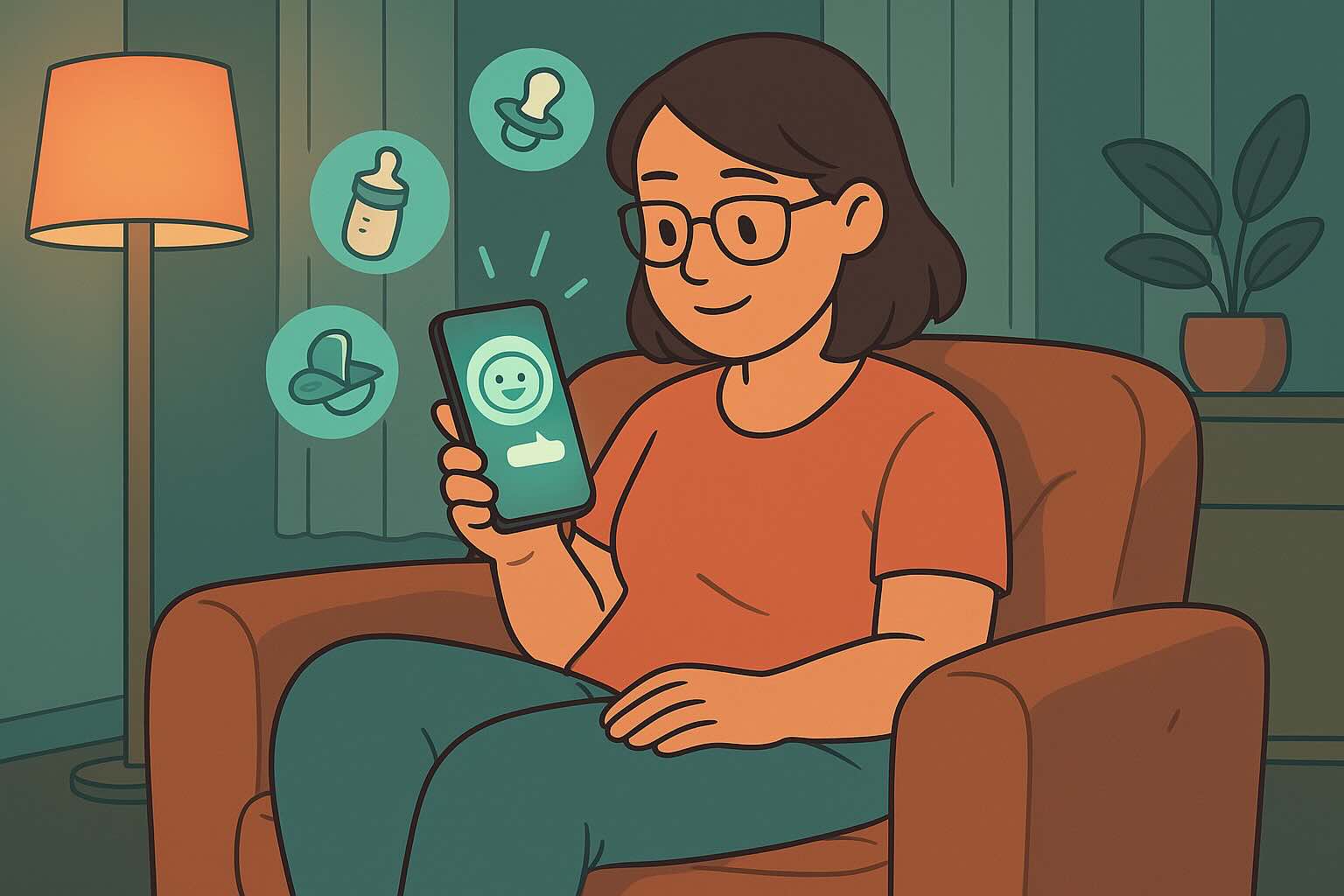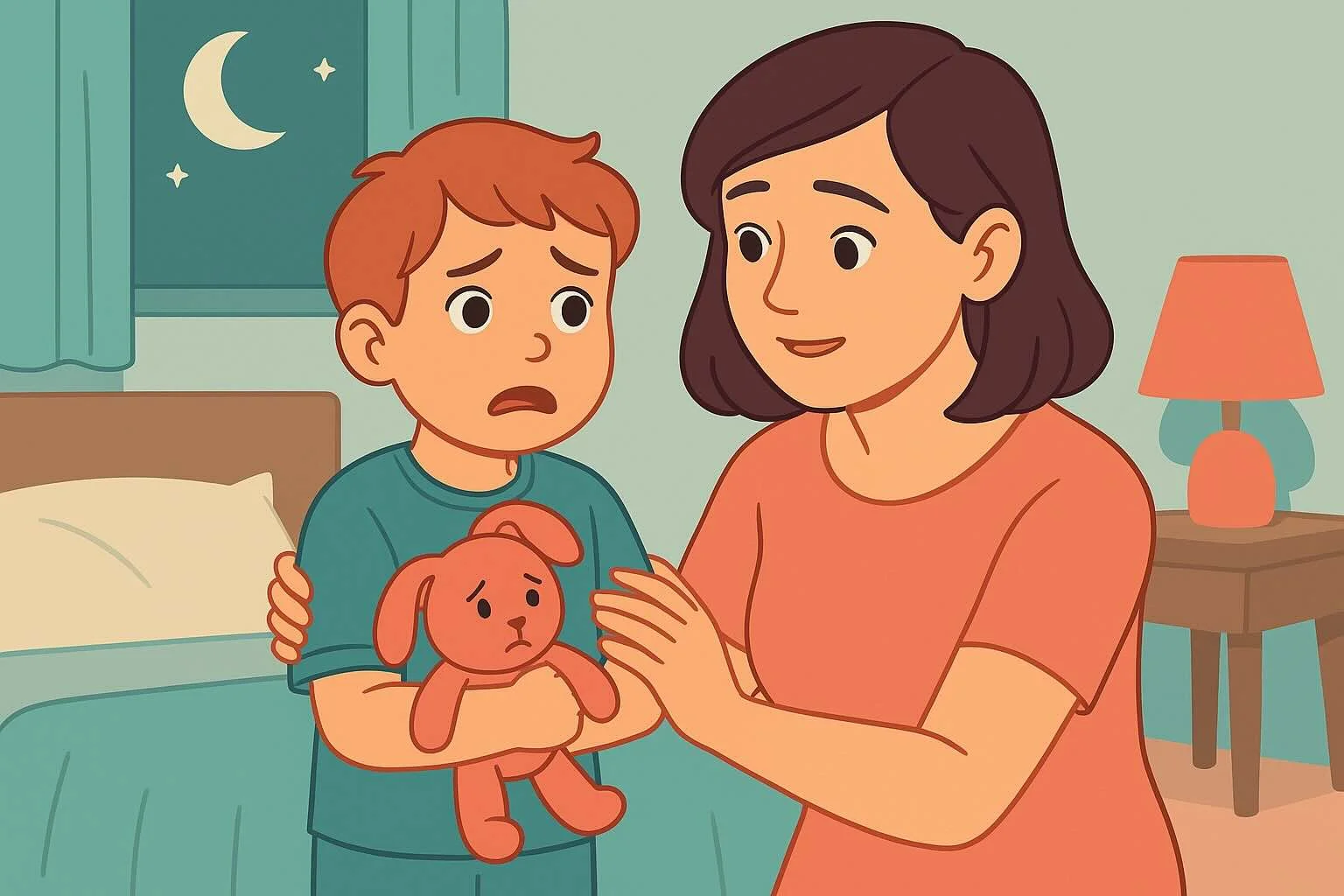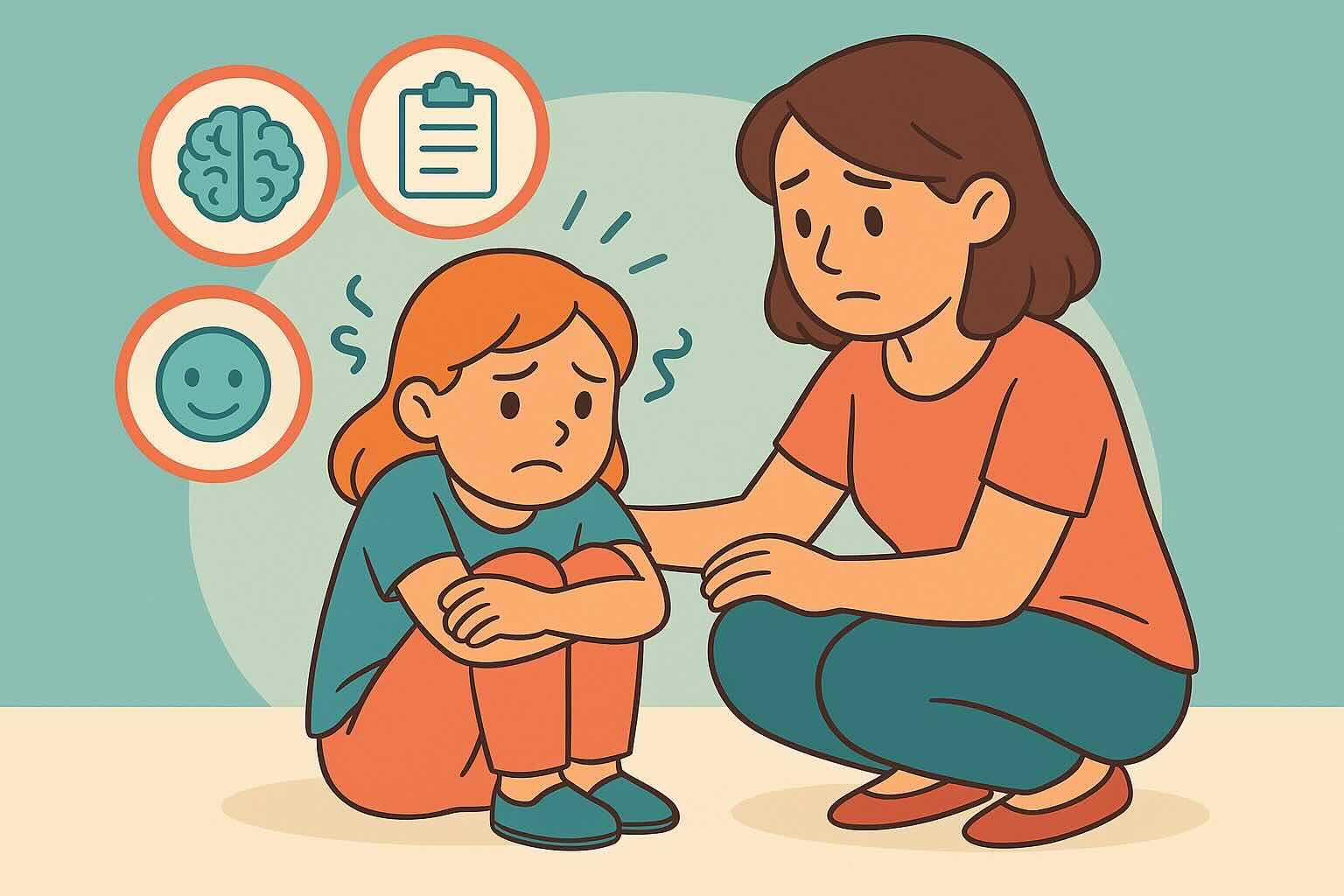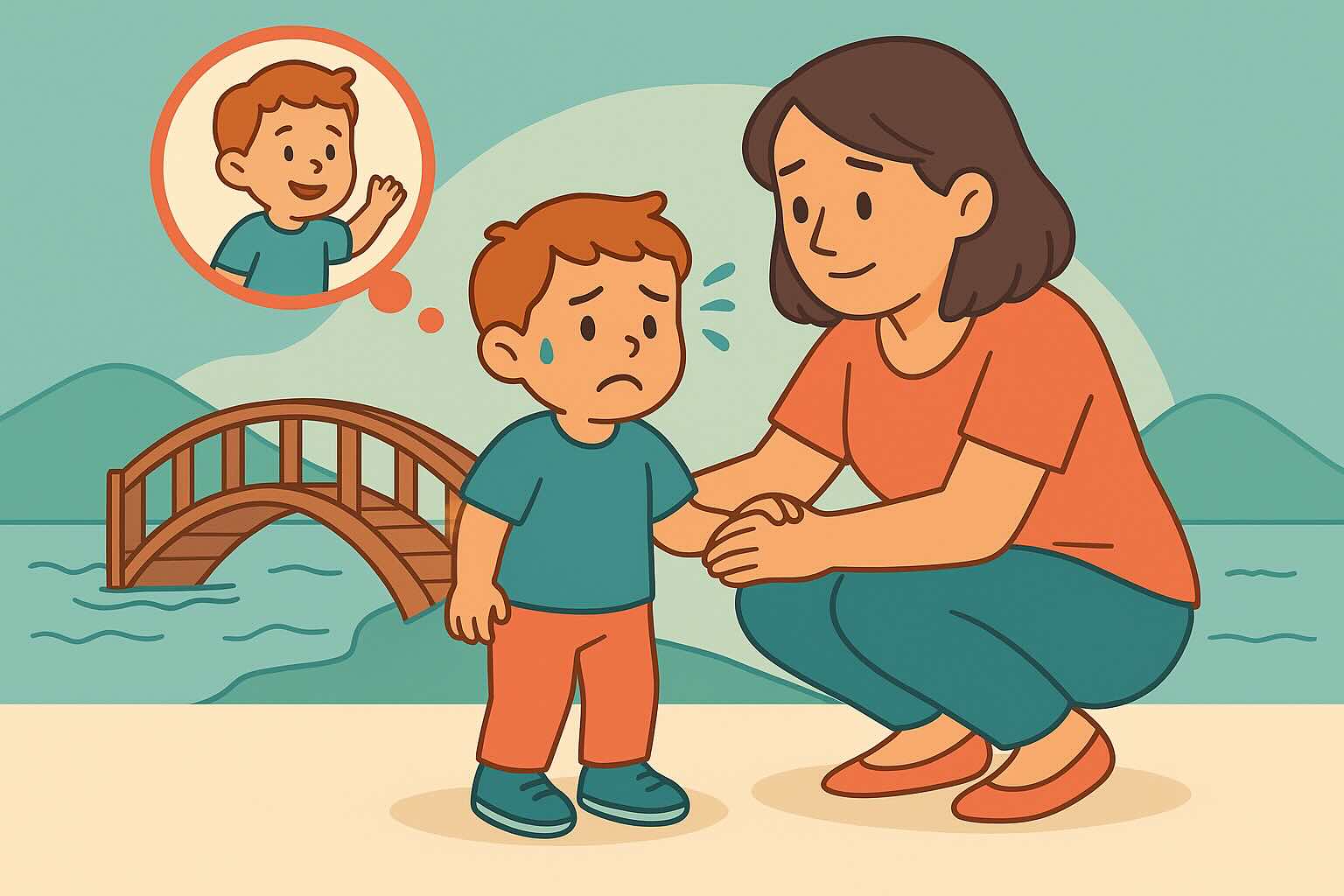When Your Child Wont Stay Alone: 7 Independence Steps


If your child follows you from room to room, refuses to play alone, or has meltdowns when you step away even briefly, you're not dealing with "clinginess"—you're witnessing a normal developmental fear. While 65% of children ages 3-7 experience room separation anxiety, this behavior often resolves with consistent, evidence-based strategies within 2-4 weeks.
This comprehensive guide provides evidence-based strategies from child development research, tested by real parents. No more guessing, no more guilt—just practical tools with realistic expectations about what actually works.
For related challenges, also check out our childhood anxiety management and nighttime fears guide. Also explore our guides on fear of new experiences and trauma processing.
What You'll Learn in This Guide
- The Real Science - Why your child's brain struggles with being alone in rooms
- Honest Statistics - Realistic data about room separation patterns and timelines
- The Two-Game Method - Exactly what to do to build comfort with brief separations
- Prevention Strategies - How to create independence-supporting environments
- Age-Specific Approaches - Different techniques for 3-4 vs 5-7 year olds
- When to Seek Help - Red flags indicating underlying anxiety disorders
- Real Parent Success Stories - How other families solved this challenge
Estimated reading time: 8 minutes
Why Children Fear Being Alone in Rooms: The Brain Science Every Parent Should Know
Your Child's Brain: Why Room Independence Is Challenging
Your child's developing brain processes being alone very differently from adults. The emotional center (amygdala) is fully operational and scanning for threats, but the prefrontal cortex—responsible for reasoning and emotional regulation—won't be fully developed until their mid-twenties.
This means your child literally cannot reason away their fear of being alone. When you leave their sight, their brain interprets this as potential abandonment, triggering a genuine stress response that feels overwhelming to their developing nervous system.
Important note: While this brain development model is useful for understanding emotional challenges, modern neuroscience recognizes that the brain works as integrated networks rather than separate "emotional" and "rational" regions. The key point remains: emotional regulation skills are still developing throughout childhood.
When Room Separation Fears Peak and Why (Ages 3-7)
During this period, several developmental factors create the perfect storm:
- Object permanence development: Understanding that you exist even when not visible is still forming
- Growing independence: They want autonomy but lack emotional regulation skills to handle it
- Imagination explosion: Can envision scary scenarios but can't yet distinguish fantasy from reality
- Control needs: Desire to control their environment conflicts with developmental limitations
- Emotional intensity: When overwhelmed, their ability to think logically decreases significantly
Normal Room Fears vs. When to Worry About Your Child
Normal room separation behaviors:
- Following parent briefly during transitions between rooms
- Calling out to check parent location when playing alone
- Brief protest when asked to stay in room independently
- Comfort-seeking when reunited after short separations
Research-based room separation statistics:
- Frequency: 65% of children ages 3-7 show some room separation anxiety
- Duration: Most children can tolerate 2-5 minutes alone by age 4 with practice
- Peak intensity: Ages 3-4, declining significantly by age 6
- Individual variation: Some children naturally need more gradual independence building
Concerning behaviors that warrant professional consultation:
- Intense panic when separated for even 30 seconds after age 5
- Complete inability to be alone in any room for months despite consistent practice
- Physical symptoms (vomiting, severe distress) during brief separations
- Regression in other independence skills due to separation fears
- Sleep disruption related to fear of being alone
- Family functioning significantly impacted for 3+ months
How to Build Room Independence: Two-Game Method That Works
This evidence-based framework uses play therapy principles to gradually build comfort with brief separations. The method works by transforming scary separation into predictable, fun experiences that children can control.
Game 1: "Can't See Me But You Can Hear Me"
This foundational game teaches children that connection doesn't require visual contact—a crucial skill for room independence.
Your first priority is maintaining emotional connection. Start in the same room together, keeping your voice calm and playful. This signals safety and fun, not threat or abandonment.
What to say:
- "Let's play a listening game!"
- "Can you see me? No! But can you hear me? Yes!"
- "I'm still here even though you can't see me."
What NOT to say:
- "You need to stay here while I go do something."
- "Big kids can play alone."
- "Don't be scared, I'm just in the kitchen."
Game 2: "See Anything With Your Imagination"
Research shows that positive imagination skills help children feel empowered rather than scared when alone. This game builds their internal resources for independent time.
How to implement:
- "Let's imagine a friendly dragon in this room. What color is it?"
- "While I'm getting water, imagine your favorite place."
- "Think of three animals and what they're doing."
- "Your imagination is so powerful, it can make any room feel special."
Step 3: Validate Independence Efforts Without Rushing
Independence-building is NOT the same as forcing separation. You're acknowledging their growing capability while respecting their developmental timeline.
Validation scripts:
- "You stayed in your room for a whole minute! That took courage."
- "I could hear you playing even when I couldn't see you."
- "You're getting braver at being alone."
Maintain realistic expectations:
- "AND we'll keep practicing together."
- "AND it's okay if some days feel harder."
- "AND I'll always come back when I say I will."
Step 4: Wait for Comfort to Build (Don't Rush the Process)
Do NOT try to force independence or eliminate fear quickly. Your job is to provide consistent, gradual practice while they develop emotional regulation skills.
During this phase:
- Stay nearby initially (don't disappear suddenly)
- Keep verbal connection constant at first
- Return exactly when promised
- Celebrate small successes without overwhelming praise
Step 5: Problem-Solve Together for Longer Independence
Once your child shows comfort with brief separations (you'll see it in their willingness to try and reduced distress), THEN you can work on longer periods and problem-solving.
Problem-solving questions:
- "What helped you feel brave when I was in the kitchen?"
- "What could you do if you start feeling scared while playing alone?"
- "How can we make your room feel extra safe and fun?"
7 Proven Ways to Support Room Independence Before Problems Start
The SAFE Method: Check These 4 Foundation Elements
Before working on room independence, ensure these foundation elements are in place:
- Secure attachment: Child feels generally safe and connected to you
- Age-appropriate expectations: Understanding developmental capabilities
- Familiar environment: Room feels safe, comfortable, and welcoming
- Emotional regulation: Child has basic self-soothing skills
Research support: Studies consistently show that children with secure attachment and emotional regulation skills develop independence more readily than those without these foundations.
Environmental Setup for Success
Create welcoming spaces:
- Adequate lighting that eliminates scary shadows
- Comfort items readily available (stuffed animals, blankets)
- Engaging activities at child's developmental level
- Easy access to parent (open doors, baby monitors for older kids)
Reduce independence barriers:
- Remove overwhelming choices (limit toys/activities available)
- Ensure physical safety so child can focus on emotional comfort
- Minimize distractions that might increase anxiety
- Create predictable room layouts that feel familiar
Proactive Independence Teaching
During calm moments:
- Read books about brave characters and independence
- Practice the two games when child is not stressed
- Play hide-and-seek to build comfort with temporary separation
- Model confident alone time ("I'm going to read in my room for a few minutes")
Teach age-appropriate coping strategies:
- Deep breathing when feeling scared alone
- Talking to stuffed animals or comfort objects
- Singing songs or humming for self-comfort
- Looking at family photos for connection
Age-Specific Room Independence Strategies
3-4 Years: The "Security First" Phase
At this age, room independence is primarily about building security and trust in brief separations.
Strategies that work:
- Very short separations (30 seconds to 2 minutes maximum)
- Constant verbal connection ("I'm washing dishes, I can hear you playing!")
- Physical comfort items always available
- Immediate return when promised
- Celebration of any willingness to try
Common challenges:
- Following you from room to room
- Crying when you step out of sight
- Refusing to play unless you're watching
- Calling out constantly to check your location
- Clinging during transitions between rooms
5-7 Years: The "Competence Building" Phase
Your child can understand more complex explanations and work toward longer independent periods.
Strategies that work:
- Longer separations (5-15 minutes) with structured activities
- Two-way communication (they can call to you, you respond)
- Problem-solving opportunities ("What will you do if you feel scared?")
- Self-advocacy skills ("I need a hug" or "Can you check on me?")
- Responsibility building ("Keep your room tidy while I'm cooking")
Common challenges:
- Wanting you present for all activities
- Difficulty with transitions to independent time
- Anxiety about what you're doing in other rooms
- Worry about emergencies or getting hurt alone
- Resistance to bedtime independence
6-7 Years: The "True Independence" Phase
Your child can handle longer periods alone and should be developing genuine comfort with room independence.
Strategies that work:
- Extended independent time (15-45 minutes) with check-ins
- Choice in activities during alone time
- Problem-solving for boredom or loneliness
- Teaching help-seeking skills when truly needed
- Building confidence through successful independent experiences
Common challenges:
- Preference for constant adult entertainment
- Difficulty initiating independent activities
- Social comparison with siblings or peers
- Academic or social stresses affecting independence comfort
- Testing boundaries around alone time expectations
Realistic Expectations About Independence Building Success
What Research Actually Shows
Room independence development expectations:
- Most families see some improvement within 2-4 weeks of consistent practice
- Significant progress (comfortable 10+ minute periods) occurs for 70-80% of families
- Complete comfort with normal alone time develops gradually over 2-6 months
- Individual variation is enormous—some children progress faster, others need longer
Important caveats:
- Highly sensitive children may need 6-8 weeks to show significant improvement
- Success often means willingness to try rather than perfect comfort initially
- Consistency across all caregivers is crucial for effectiveness
- Life changes (new sibling, moving, school changes) can temporarily increase clinginess
When Independence Building Doesn't Work as Expected
After 6-8 weeks of consistent implementation:
- Consider your child's individual temperament and sensory needs
- Evaluate family stress levels and major life changes
- Consult pediatrician about potential developmental or anxiety issues
- Consider occupational therapy evaluation for sensory processing challenges
- Remember that some children need specialized approaches or more time
When to Seek Professional Help
Red Flags That Warrant Professional Consultation
- Intense panic when separated for even 30 seconds after age 5
- Complete inability to be alone in any room despite 6+ weeks of consistent practice
- Physical symptoms (nausea, headaches, panic attacks) related to room separation
- Regression in other independence skills (toileting, dressing, sleep)
- Room separation fears that worsen rather than improve with support
- Inability to attend school or participate in normal activities due to separation fears
- Family functioning significantly impacted for more than 3 months
- Self-harm behaviors related to separation distress
Types of Professional Support Available
Child psychologists specialize in separation anxiety and attachment-related concerns Play therapists use therapeutic play to address fears and build confidence Occupational therapists help with sensory processing issues that may contribute to separation difficulty Pediatricians can rule out medical causes and provide developmental perspective Family therapists assist when separation issues affect family relationships
How to Find Qualified Help
- Start with your pediatrician for appropriate referrals
- Contact your insurance company for covered providers in your area
- Look for specialists with specific experience in early childhood anxiety and attachment
- Ask about their approach to ensure alignment with your family values
- Consider university training clinics for evidence-based treatments
Real-Life Success Stories
Emma's Story: The Bathroom Independence Victory
"My 4-year-old Sophie wouldn't even use the bathroom alone. I started with the listening game - I'd wait right outside the door and narrate what I was doing: 'Mommy's right here, organizing the hall closet.' Then we practiced the imagination game - she'd imagine her favorite characters visiting her in the bathroom. After three weeks, she was using the bathroom independently and even started taking solo baths. The key was making it fun, not forced."
Mike's Story: The Playroom Transformation
"My 5-year-old wouldn't play in his room unless I sat there too. I felt like a prisoner. We started with the games during calm times, then applied them when he played. I'd go fold laundry in the hallway while he played, and we'd use the listening game. I'd call out what I was doing, he'd respond about his play. Now he plays independently for 30-45 minutes while I get things done. He still calls out to share his adventures, but doesn't need me physically present."
Lisa's Story: The Morning Routine Independence
"Getting my 6-year-old dressed was impossible because she wouldn't stay in her room alone. We practiced the imagination game - she'd imagine fun characters helping her get dressed. I'd be nearby but not in the room, talking about my morning routine. Within a month, she was getting dressed independently while I made breakfast. She'd call out funny things her 'imagination friends' were doing, and I'd respond. It became a fun part of our morning instead of a battle."
Your Realistic 6-Week Action Plan
Weeks 1-2: Foundation and Assessment
- Observe current patterns without changing anything major
- Begin practicing both games during calm, together time
- Start with very short, successful separations (30 seconds to 2 minutes)
- Focus on building positive associations with brief alone time
Weeks 3-4: Skill Building and Practice
- Increase separation duration gradually (3-5 minutes maximum)
- Add real-world applications (bathroom trips, getting items from other rooms)
- Maintain constant verbal connection during separations
- Celebrate every success, no matter how small
Weeks 5-6: Independence Expansion
- Work toward longer separations (5-15 minutes for older children)
- Reduce verbal frequency gradually (check-ins every few minutes instead of constant talk)
- Add structured activities during alone time (puzzles, specific toys)
- Practice problem-solving: "What will you do if you feel scared?"
Ongoing: Consolidation and Growth
- Maintain regular alone time as part of daily routine
- Continue building skills during calm periods
- Plan for setbacks during stress, illness, or life changes
- Celebrate growing independence and confidence
The Long-Term Impact: Building Confidence and Self-Reliance
Remember, every time you support your child's independence building with patience and consistency, you're helping develop crucial life skills. You're not just solving a room separation issue—you're building the foundation for their future confidence and emotional resilience.
Research shows that children who develop healthy independence early:
- Have better emotional regulation and self-soothing skills
- Show increased creativity and problem-solving abilities
- Develop stronger sense of self-efficacy and confidence
- Have better peer relationships due to reduced clinginess
- Perform better academically due to improved focus and independence
Key Takeaways: Your Room Independence Guide
- ✅ Room separation fears are developmentally normal for 65% of children ages 3-7
- ✅ The Two-Game Method works when used consistently but requires patience and practice
- ✅ Your child's brain is still developing independence and emotional regulation capabilities
- ✅ Prevention through environmental setup is more effective than forcing separation
- ✅ Age-specific approaches respect developmental needs and capabilities
- ✅ Realistic improvement takes 2-6 weeks with significant individual variation
- ✅ Professional help is available if fears become severe or don't improve
- ✅ You're building lifelong confidence and self-reliance skills
- ✅ Consistency and realistic expectations lead to long-term success
Remember: You're not just teaching your child to be alone in rooms—you're building their confidence to handle challenges independently. Progress is often slow and non-linear, and that's completely normal.
This article is based on peer-reviewed research in child development and attachment theory. Individual experiences vary significantly based on child temperament, family circumstances, and implementation consistency. Always consult with your pediatrician if you have concerns about your child's emotional development or anxiety patterns.
24/7 AI Parenting Assistant
Get instant, personalized advice with expert-curated parenting knowledge. Chat with your AI coach anytime, anywhere.

Childhood Anxiety Management Toolkit
Complete toolkit with coping strategies, validation techniques, and activities to help your anxious child build confidence.
Frequently Asked Questions
Need personalized support?
RootWise's AI coach can provide tailored strategies for your specific situation, available 24/7 when you need it most.
Learn More About AI Coaching →



